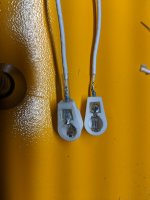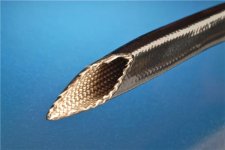I'm placing some small (1/4 W) resistors in the ceramic tube caps for the grid of some 2C22 tubes. I want to support my soldered joints with some heat shrink tubing but am wondering about the insulating effect of the tubing. Am I right to be concerned? This will be the second stage of a preamp.
Attachments
Last edited:
I have some of that too and was going to use that as well but I was thinking that the heat shrink would reinforce my solder joints better.
A solder joint that is not strong enough, needs to be re-soldered.
Then, the small bodied resistor becomes the weakest link.
And yes, I prefer using the heat shrink there, it will not move.
Spaghetti without the shrink can move, unless you glue it.
I am not familiar with a 2C22, but a grid normally has less signal voltage, and less DC voltage than the plate does.
Hopefully any garden variety shrink tubing can handle the grid voltages.
Then, the small bodied resistor becomes the weakest link.
And yes, I prefer using the heat shrink there, it will not move.
Spaghetti without the shrink can move, unless you glue it.
I am not familiar with a 2C22, but a grid normally has less signal voltage, and less DC voltage than the plate does.
Hopefully any garden variety shrink tubing can handle the grid voltages.
Last edited:
I believe my joints are as strong as the next guys. I just though I'd add a little support so removing and replacing the caps wouldn't fatigue the joints. The question related to temperature.
Thanks
Thanks
A 2C22 is half a 6SN7. Military version with the plate and grid on the top. I like them for the visual effect and there is little demand for them.


Where the resistor lead is soldered to the terminal itself is also subject to fatigue. I might think about filling up that cavity with epoxy or at least RTV to keep the resistor lead from flexing there at all.
- Home
- Amplifiers
- Tubes / Valves
- Resistors and Heat Shrink

